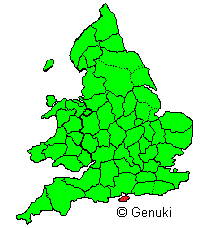Hide
Isle of Wight
hide
Hide
hide
Hide

Hide
Hide
The island lies off the south coast of Hampshire, within the jurisdiction of which it is included. The Solent sea, separating it from the mainland, varies from four to six miles across, while at one point, near Hurst Castle, it is more than a mile. The island is of a lozenge shape, 22.5 miles from east to west, 13 from north to south, about 60 in circumference and including 93,341 acres. On the north the land slopes to the margin of the sea, woods and meadows stretching to the water's edge; but on the southern shore is a precipitous barrier of cliffs, with here and there a stream falling through a ravine; occasionally the coast curves inward, and at either extremity is a bold rocky promontory. It's geological structure is interesting, as it includes several strata, from the tertiary to the wealden formation, and which in some places are closely compressed together. A high range of chalk hills, or downs, stretch from east to west, and a still higher range runs southward, terminating abruptly at the Undercliff, which enjoys a high reputation for its picturesque scenery and the mildness of the atmosphere: it consists of various shelves, from a quarter to half a mile in breadth and 6 miles in length, gradually sloping to the sea, caused by landslips from the chalk downs. St. Boniface Down, at Ventnor is the highest in the island, being about 900 feet in height: on Ashey Down, which is 420 feet above the sea, is a sea mark, built of stone by the Trinity Board in 1795. The Needles, at the western extremity, are isolated masses of rock, principally chalk and flint: the Needles lighthouse is on the highest point of this part of the island, and St. Catherine's Point, at the southern end, is another lighthouse. Near here is a rock worn by the action of the sea into the shape of the arch; the cliffs at this part rise to the height of 600 feet, and are frequented by numbers of aquatic birds.
The island is under the control of a governor, who is styled the Governor and Captain-General: it forms a magisterial division of Hampshire and contains the liberties or hundreds of East Medina, with 14 townships or parishes, and West Medina with 16: it is within the archdeaconry of the Isle of Wight and diocese of Winchester, and is divided into the rural deaneries of South-East, West and North-east Medina: as a parliamentary district it returns one knight of the shire; the borough of Newport returned two members, but was disenfranchised, by the "Redistribution of Seats Act, 1885".(Transcribed from Kelly's Directory of the Isle of Wight, 1886)
Hide
- Isle of Wight Churches which includes a map which is clickable taking you to many of the island's churches (includes photographs, current and historical information).
- Ted Wildy's UK Marriage witness index includes the Isle of Wight].
- A transcription of the section for the Isle of Wight from the National Gazetteer (1868) provided by Colin Hinson.
- A transcription from Kelly's Directory of the Isle of Wight, 1886
- Researchers may be interested in the Isle of Wight GenWeb pages.
- Ann Barrett provides a variety of information helpful in Isle of Wight genealogy, including some indexes of school registers, some hospital admissions, Customs and Excise prosecutions, warders and prisoners in Parkhurst.
- Ann Barrett has several lists of people of particular professions - people associated with coastguards, lifeboats, lighthouses, also soldiers. An example is a list of people connected to coastguard and lifeboat stations, extracted from Kelly's Directory for 1898.
- We have Stan Waight's information about coastguards, including the Isle of Wight
- Isle of Wight Brick Making History - Lots of information about the history of the craft includes some Island Brickmakers.
